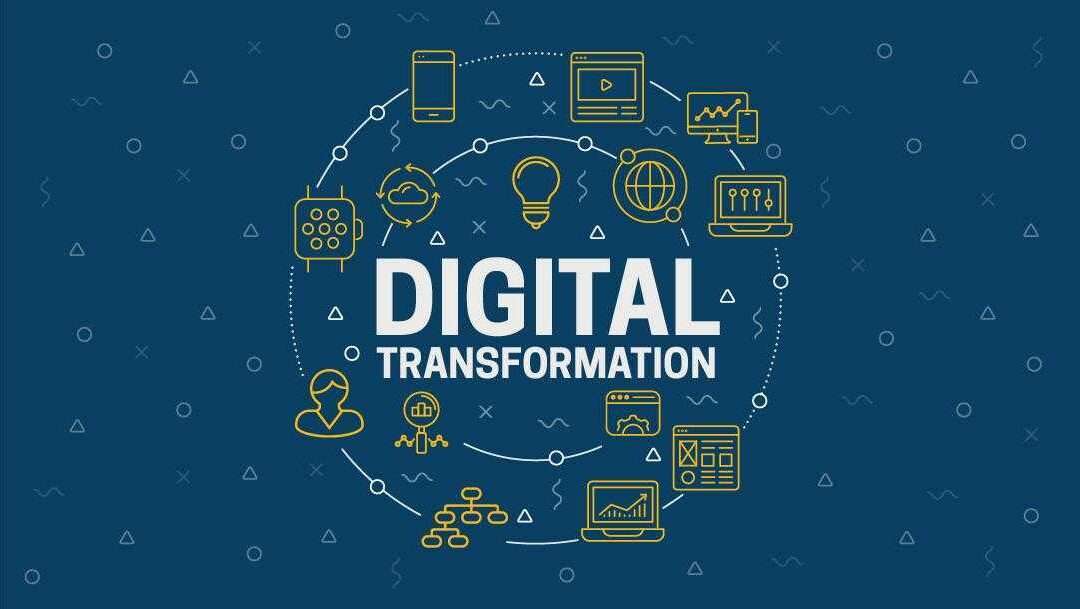Digital transformation and innovation are crucial to the success of any business in today’s world, but what does this mean? How do you apply them to your business? Is there anything more that you can do to help your business succeed in the digital age?
The digital age is upon us and it’s not just changing the way we communicate with each other or how we spend our free time – it’s altering the very landscape of business as we know it.
Businesses everywhere are struggling to transform from being just good at what they do to being innovative and disruptive, as this will be key to their success in the future, just like it has been for Uber, Airbnb, Tesla and others in recent years. This guide will help you on your journey to digitalising your business.
What is Digital Transformation?
Digital transformation and innovation is the process of transforming your business into a digital-first company. Digital transformation is not just about making your website mobile friendly or replacing a desktop computer with a tablet. It is about becoming customer-centric, data-driven, digitally enabled and digitally engaged. These changes will help you grow, reach more audience, increase sales and generate more ROI.

The core of digital transformation is to look at how technology, innovation, strategy and model can help you grow, reach more audience, increase sales and generate more ROI. The key aspects of digital transformation are digitalisation, analytics, automation and decentralisation. These aspects are keys to create a better customer journey across all touch points – online or offline. From business idea creation (digitalisation) all through product manufacturing until it gets delivered into customers’ hands (automation) in a very short time thanks to data-driven insights (analytics). What does decentralisation mean for your business?
Decentralisation means giving your customers or employees more decision-making power. Let your customers shop in a very personalised way and give them exactly what they want. Let employees shape their own careers by offering them professional training, guidance and development opportunities.
Having empowered your team with digital tools, you can be confident that digital transformation has done its job – your business will start growing, reaching more audience, increasing sales and generating more ROI!
7 Tips for Digitalising Your Business
1. Approach your digitalisation with a business-first mindset – in other words, what’s in it for the customer or the business owner.
2. Digitize your data – make sure that any data you have stored digitally can be retrieved quickly and efficiently when needed.
3. Create a digital roadmap that includes an action plan for how to apply technology in your business.
4. Establish goals for digitalisation and measure them regularly.
5. Look at which aspects of your business would benefit from automation: what processes could be replaced by software, robots or apps?
6. Don’t forget about partnerships – who do you need to work with on this project, and what are their skillsets?
7. Explore opportunities for innovation, such as combining old practices with new technologies (e.g., use artificial intelligence to analyse your customer interactions).
The world is full of data. There are more than two million gigabytes of data generated every day. That’s 1000 TB an hour, 10000 TB in 8 hours, 200 000 TB in a day! With so much data generated every day, it’s not enough that you get insight into your data once or twice a year. Data should be available right when you need it; real-time insights with predictive analysis capabilities allow you to put that information into action.
Analytics should be an integral part of your business strategy, flowing through every area of your business, from customer journeys to reporting. The core of data-driven insights is data, which in itself isn’t valuable unless you know how to use it. That’s why your team must understand how data analytics work so they can make informed decisions regularly.
Digital transformation involves increasing automation for businesses to speed up processes and react faster to change without human involvement. This means putting more systems online where customers can complete processes themselves instead of contacting support, for example.
By automating certain tasks like sending out customer satisfaction surveys automatically after purchases, you can collect relevant feedback automatically and respond appropriately to questions before they become problems. In addition, when it comes to customer service and user experience design, we shouldn’t forget there are many other channels apart from our websites or social media accounts, such as chatbots or voice assistants like Siri and Alexa. Making these channels conversational means people who use them don’t have to wade through masses of text; they’re able to ask questions using natural language and receive clear answers quickly.
The last key aspect of digital transformation is decentralisation: let your customers decide! They are the ones who live with your products every day so let them choose how things happen around here too.
How To Approach Digital Transformation and Innovation
An overarching digital transformation strategy guides business leaders, helping them make important decisions about how best to pursue growth with digital innovation.

Understanding digital transformation means having a firm grasp of how businesses reach customers quickly and what digital innovation can do for them. Digital business transformation, digital innovation, digital strategy, and many other concepts are all components of digital transformation. So, where should we start?
Let’s look at digital transformation approaches: there are four main approaches to digital transformation, namely:
- Tactical
- Holistic
- Evolutionary, and
- Revolutionary.
Which one is right for your business?
Here’s how each approach differs from one another:
Tactical approaches involve short-term efforts that don’t include significant changes to business models or processes.
Holistic approaches involve changing major aspects of organisations’ operations, including processes, organisational structures, people practices and more.
Evolutionary changes only involve tweaks that address specific needs–they won’t transform the entire company but will help it evolve along with its environment.
Revolutionary changes involve overhauling everything–nothing is off-limits here!
As you can see, choosing which approach is right for your business depends on many factors, including strategic goals and industry specialisation (for example). To learn how to make data-driven decisions for your organisation, get a copy of the Decision-Maker’s Handbook.
Why Is Digital Transformation the Hope of Most Organisations?
Business digitalisation approach goes hand in hand with digitisation, innovation and automation. The future of business lies in the new digital world, where trends are constantly changing, and businesses need to keep up. One way for them to do this is by using a business-centric digitalisation approach that helps them stay on top of the latest developments. This process involves understanding how to use technology for your benefit, the potential risks it poses, who you need as partners to succeed, and more.

Digitalisation comes with a number of benefits. It improves processes, enables businesses to reach new audiences, helps them save money on overhead costs, and boosts sales. You’ll also have more freedom because it allows you to work from anywhere as long as you have an internet connection. You can cut down on travel expenses or shift your office hours, so you’re able to spend time with family or do things you love without being tied down by conventional working hours. Plus, since digital tools are usually less expensive than traditional ones, it opens up new opportunities for small businesses that couldn’t afford them before.
The transformation process isn’t easy, but it can be managed. This means understanding your current stage, where you want to go, how much time you have available, and how your organisation works. After that, you can assess your strengths and weaknesses and plan for a successful change. If needed, you can get help from partners with more technical know-how than yours. It’s also vital to update employees on plans to understand why things are changing and how they will benefit from new services or offerings once digitalisation is complete. Once everyone agrees on a direction, it will be easier to follow through with your plan so you can keep up with new trends.
While digitalisation can be an opportunity, it’s essential to be aware of challenges. One of these challenges is protecting your company from data breaches and other security issues that can arise when working in a digital world. That’s why it’s so crucial for companies to follow good security practices like using complex passwords, maintaining up-to-date software, investing in firewalls or virtual private networks, encrypting data where possible, and not sharing sensitive information with unauthorised people. It also pays off to get regular IT audits, so you know what needs improvement when digital transformation is complete.
Approaching Your Digitalisation with A Business-First Mindset
Digitalisation has been a hot topic in the business world for some time now, with many different opinions on how best to approach it. For example, some companies have embraced digitisation by investing heavily in new technology, and others have taken a more cautious approach. However, one thing remains true across all these approaches: digitalisation should be approached with a business-first mindset.
The business-first approach means putting your customer’s experience first when implementing new changes. You can then bring in digitisation as a way of enhancing that experience, not just replacing it. Businesses are still in a period of digital transformation, but many now believe that digitalisation will soon become an integral part of doing business. For example, since its introduction, e-commerce has taken off because it provides customers with easy access to buy from their favourite brands or products anytime and anywhere.
So, in what ways can you incorporate a business-first mindset when approaching your digitalisation?
First, identify where you want to go before setting out on your journey – do you want to use digitisation as a way of automating processes within your company or do you want to make your company accessible online?
Next, stay ahead of the curve by assessing which areas need work and improving them accordingly.
Finally, be sure to share updates with employees, so they know what they are working towards!
Businesses must take a whole ecosystem perspective when thinking about digital development, both internal (staff) and external (customers). When applied strategically, this ‘business first’ approach will allow organisations to look at developing strategies for digital change opportunities with consumers in mind. Ultimately, such changes need careful consideration, so it’s worth remembering: always think about the business before anything else!
How Do I Get Started With Digital Transformation?
There are two ways you can get started with digital transformation. The first way is to look at your business’s current operations. How does your marketing strategy work? How do you use technology in your current operations? What are some of the areas where you would like to improve? This can help guide you on how digital transformation could be applied to your business. The second way is to look at what other companies in similar industries are doing in terms of digital transformation.

If you want your company to get started with digital transformation, here are three things that you need to keep in mind:
1. Making a roadmap for digital transformation
2. Transformational strategies
3. Incorporate technology into your business process as soon as possible.
Start small by implementing new technologies one at a time until you find something that has the potential for growth and efficiency improvement. Take care not to disrupt your current business model or system when introducing new technologies into the organisation – this can cause more harm than good.
If you want to implement digital transformation within your business, here are six other points that you should take note of:
1. Treat it as a holistic process
2. Start with small changes
3. Find business models relevant to your business
4. Adopt different strategies for different stages of transformation
5. Understand digital innovation
6. Enhance customer satisfaction levels by taking advantage of digital transformation’s benefits.
Increase sales, reduce costs and generate higher ROI from the products and services offered through innovative methods. It’s never too late to start the digital transformation, and there are many steps you can take today to improve in the future.
Research shows that 45% of executives believe their organisation will struggle to adopt and leverage digital change due to insufficient IT budgets. But in practice, investing in digital transformation means investing in the continued success of your company.
Your purpose for implementing digital transformation should be clear. If done right, it will create better business opportunities. Studies also show that it improves productivity, saves money and attracts new customers.
Getting started with digital transformation can seem like a big leap if you take action now.
Here are some more guidelines you can follow to get started with digital transformation:
1). Determine what’s important for your business
2). Follow a process that includes planning, team collaboration, budgeting and risk management
3). Apply project management skills
4). Be flexible in making changes
5). Ensure that employees are trained in new areas
6). Choose an implementation path that makes sense for your business goals.
For example, if you’re interested in increasing customer satisfaction levels and gaining a competitive advantage over your competitors, then apply CRM tools to understand precisely who your customers are.
If you want to enhance product offerings and processes through data analytics, invest in predictive analytics software that provides real-time data analysis and automation capabilities to adapt to continuously changing environments. With these simple tips, getting started with digital transformation doesn’t seem so daunting anymore! As the saying goes, a journey of a thousand miles begins with a single step. To digitalise your business, you can take that first step by planning how to proceed.
Steps you can take right now to begin with digital transformation include: understanding your business needs and defining your long-term vision, developing a road map for achieving your long-term vision, and identifying stakeholders and partners. This can be achieved through brainstorming sessions, surveys, interviews and stakeholder workshops. You should also ensure that you have the necessary resources needed to bring about digital transformation, such as funds, people and organisational commitment.
This article has given you some basic information on how to go about starting with digital transformation in your business.
How Can Digital Innovations Work for Organisations, Including Mine?
Digital innovation can be difficult for organisations that are not as tech-savvy or don’t have access to the right technologies. However, digital transformation can work for any business by boosting productivity and connectivity and creating a better customer experience. With digital innovations, companies can stay ahead of the competition by adopting new technologies that will change the way their customers interact with them. Moreover, businesses need to invest in digital transformation to be more prepared for future innovations.

There are many reasons why digital transformation can work for organisations.
For example, in today’s marketplace, customer experience greatly differentiates one business from another. If your customer has a negative experience with you, they’re likely to take their business elsewhere. Also, if your company doesn’t offer online ordering, you’re at risk of losing revenue because some customers may not prefer in-store shopping.
Another reason digital transformation can work for organisations is that it helps them reach audiences who previously couldn’t access your products and services, which allows companies to increase sales and generate more ROI.
Some of today’s most successful businesses have taken advantage of digital transformation. For instance, Amazon, Netflix and Instagram are just a few companies that started small but quickly grew due to their use of digital innovation. Over time these innovative companies could build robust networks around their businesses, something brick-and-mortar stores cannot compete against. Plus, with the rise of artificial intelligence, augmented reality, and virtual reality, consumers are looking for ways to engage digitally, including shopping in physical stores and connecting virtually through social media sites such as Facebook.
Because digital innovation allows businesses to connect with customers, grow their customer base and increase revenue, organisations must take advantage of these new technologies. As you consider how you want to grow your business through digital transformation, develop a plan that includes all of your systems, including marketing initiatives and other in-store or brick-and-mortar options.
Digital Transformation Models You Need To Know
Digital transformation models have become essential to any business, big or small.
Digital transformation models may sound new to you, so it’s important to know what they are and how they can benefit your company. Below, we’ll outline the four most common types of digital transformation models and show you how to get started with each one.
- The digital innovation model aims to re-invent your business and its processes, turning them into something more suited for a digital world.
Start by thinking about how you can utilise disruptive technologies and better serve your customers through technology. The next step is getting buy-in from senior leadership and staff members, after which you’ll be ready to execute your vision. You should also plan to create new metrics that align with your digital strategy and devise different ways to measure progress.
- The transformative change model will ensure that you’re constantly evolving as an organisation, moving towards success no matter what comes at you.
Think about how to keep learning – taking advantage of all the opportunities for personal development – and using various methods like case studies, video conferencing and training programmes.
- The automation transformation model focuses on harnessing data science to create automated systems which will reduce costs while improving efficiency across many different areas of your organisation.
You should use data analytics tools such as CRM software or ERP systems combined with machine learning algorithms like artificial intelligence (AI) to help make this possible. To begin, identify high-priority tasks where automating will produce clear benefits. What other tasks could be completed by automating similar high-priority tasks? Write down all the steps required to automate each task, assess the cost and benefits of implementing these changes and then decide if it’s worth doing! Finally, don’t forget to consider the people side of things; while automation makes certain jobs obsolete, those individuals need somewhere else to go within your company!
- The Agile transformation model takes an iterative approach to achieve goals; rather than following a linear process to reach objectives, teams start with their current state before setting measurable targets for improvement, which are then regularly reassessed throughout the process.
Within this model, workflows in short cycles are known as sprints, and every process ends with a review of how successful the sprint was based on project goal completion rates. Every sprint starts with requirements analysis – deciding exactly what needs to be done during that cycle to fulfil project requirements – followed by design and implementation. After implementation has been completed, the cycle begins again, focusing on bug fixing before reviewing lessons learned from the last cycle. It’s crucial to note that agile transformation applies to organisations looking for creative ideas and enterprises seeking predictability in their operations.
Companies today often find themselves overwhelmed by digital transformations because they are unprepared. In fact, research suggests that the average company in the UK spends just 2.6% of its time on digital transformation and innovation.
So how do you even start?
One of the first steps is getting senior leadership and employees on board with your vision, which will require some convincing!
Next, you’ll need to define your digital strategy. This will include coming up with a new set of metrics that align with your digital transformation and how you’ll measure progress along the way. The critical point here is to make sure you can demonstrate what’s working and what’s not – this will be key when presenting your strategy internally.
The innovation model discussed above will be handy at this stage because it looks at making sure your company innovates by fostering both new products and processes, ultimately attracting more customers in a rapidly moving digital transformation market. Start by listing your current products and services and developing blueprints for new offerings.
You should also determine whether or not these will be physical or virtual products, how they fit into existing systems, if any security updates are necessary, how they can be manufactured and what support channels they’ll require (for example, customer service agents). Once you’ve got everything down on paper, make sure you communicate these ideas with colleagues – especially when it comes to senior leadership – since they are likely to have some good suggestions.
Take The Next Steps Towards Transforming Your Business Digitally.
Customer-centricity drives digital transformation! Being customer-centric is a key part of a digitally focused organisation as it allows you to develop unique customer insights. Taking the customer’s perspectives will enable you to build a competitive advantage with better business outcomes leading to ROI on your investments in digital transformation initiatives.

Now, what does that look like?
Digital transformation can be a complex process. You’ll need to decide what you want your company’s core values to be and then align your business around those values. This includes identifying the data you need to make better decisions, establishing an IT strategy, and improving collaboration internally and externally with customers. Contact Tesseract Academy today so we can work together to transform your business digitally.

























